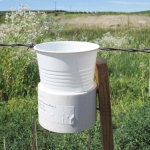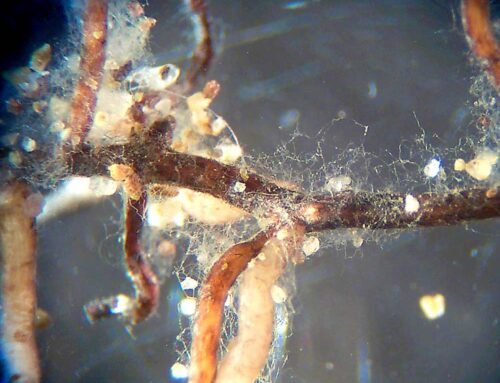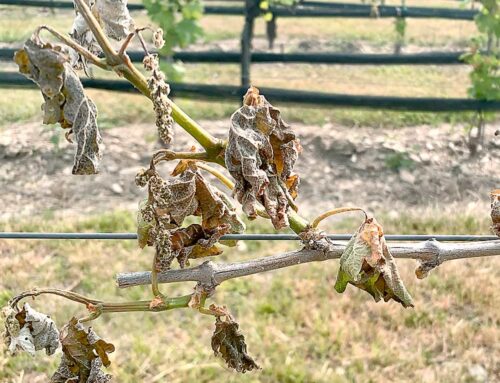Preliminary research shows that few bee pollinators are found in wine or juice grape vineyards of eastern Washington, an important finding if neonicotinoid pesticides are further regulated. Provado (imidacloprid), a key insecticide used by Washington grape growers, is in the neonicotinoid class.
The plight of the honeybee has caught the attention of folks worldwide. Although research has implicated neonicotinoids as a factor in the loss of honeybees, there are multiple reasons for declining bee populations. Bees live in a toxic world and face many stresses, including loss of habitat, lack of genetic diversity, pesticides used to control Varroa mite, and more.
“Environmental groups are using the cause of bee conservation and safety as a reason to further regulate pesticides, such as neonicotinoid pesticides,” said Dr. Doug Walsh, integrated pest management specialist for Washington State University.
Walsh and a team of WSU researchers initiated a bee survey last summer in wine and juice grape vineyards. Grapes are wind-pollinated and don’t need bees for pollination.

Dr. Doug Walsh
However, documentation of bee populations in vineyards will be valuable information if restrictions are placed on neonicotinoids in the future, he explained.
“We really don’t see a lot of bees in our vineyards in eastern Washington,” Walsh said during a meeting of the Washington State Grape Society. Additionally, because most wine grape vineyards are drip irrigated, cover crops, including flowering ones that could attract bees, are rarely grown in wine grapes. “But we need to prove that we have few bees in our vineyards in case Provado comes under fire in the future.”
Imidacloprid has become an important pesticide used by growers to control grape mealybug, scale, and leafhoppers, all of which are either known or suspected vectors of grapevine viruses. Imidacloprid is a systemic insecticide commonly applied through the drip system.
Party cups
WSU graduate student Courtney Grula surveyed hops, grapes, and blueberries in the search for bee pollinators. She used white, blue, and yellow plastic party cups as “bee bowls” to quantify and qualify bee populations in eight vineyards (four wine grape and four juice grape), four hop fields, and four organic blueberry fields.
Grula also sampled bee populations in areas near the surveyed crops that had flowering plants, undisturbed habitat, and open water.
Two party cups of each color were placed in each site on a weekly basis from May through August. Bees were collected in a 24-hour period. Grula used a total of 1,590 traps in her sampling. WSU’s Dr. Richard Zack, director of the M. T. James Entomological Collection in Pullman, identified the bee species.
Bee species
Bees from three insect families were caught in the traps—Apidae (European honeybees), Halictidae, and Megachilidae.
Native bee species in the Halictidae family that were collected included the metallic-green sweat bee (Agapostemon), the alkali bee (Nomia melanderi), another sweat bee (Halictus farinosus), and the alfalfa leafcutting bee (Megachile rotundata). The alfalfa leafcutting bee is an important pollinator of alfalfa seed in Washington. Native species are solitary dwellers and build nests in the ground or in cavities.
Preliminary results of the trapping show that bees in the Apidae family were most commonly found in blueberries, riparian areas, and hops, with very few trapped in Concord or wine grape vineyards.
“It’s not surprising that honeybees were found in blueberries because growers put hives in blueberry fields to help with pollination,” Walsh said. He added that flowering weeds growing at the base of hop plants appeared to be the reason Apidae honeybees were attracted to the hop fields.
Megachilidae were the most prevalent species in riparian areas. Across all sites, species in the Halictidae family were the most prevalent.
Data from the one-year survey showed that Concord and wine grapes are poor habitat for all bee types, Walsh said.
Honeybees were observed visiting drip emitters and puddled water in several of the cropping systems that were surveyed. Walsh suggested that to reduce potential impact on bee populations from neonicotinoid insecticides applied in the drip system, chemigation could be done at night when bees aren’t active.
“The good news for grape growers is that insecticides applied to vineyards will have minimal impact on extant bee populations,” he concluded.
Although Walsh plans to repeat the pollinator research this season, he believes the survey provides the Washington grape industry with strong data to show that growers are not harming pollinators with current pest control practices. •







Leave A Comment